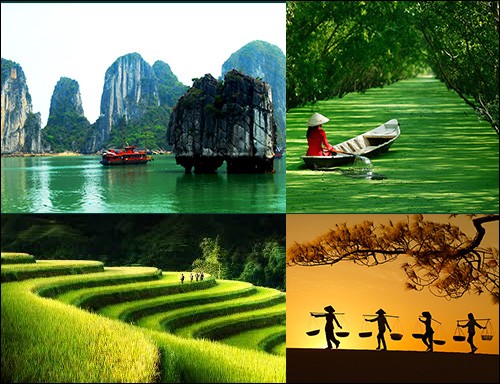With her origins shrouded in the mists of time, Vietnam has evolved a rich oral tradition of myth and legend. Vietnamese mythology contends the people are descended from a dragon and a fairy. The union of the dragon, King Lac Long Quan, and the enchanting mountain fairy Au Co produced one hundred offspring. The eldest son became the first King of the thousand year Hung Dynasty. This dynasty is commemorated to this day as the bud from which the Vietnamese nation ultimately flowered.
Throughout time, Vietnam has forged her identity through the highs and lows of history. Today she has become a robust and vibrant commercial hub and thriving travel destination in the heart of Southeast Asia.
With her 3,000 km coastline bejewelled with sun-drenched sandy beaches imbued with a vast array of resorts and hotels, Vietnam has established a growing reputation as a first-class beach destination.
Possessing a unique cultural and historical heritage, Vietnam is an idyllic choice for travellers in search of exotic travel experiences not to be found anywhere else. A grand exploration delves deep into the heart-warming natural hospitality and charm of the peoples and soul-stirring landscapes of Vietnam.
Here are some highlights of the amazing variety of the Vietnam experience:
- Geography & Climate:
Northern Vietnam borders Laos and China. It has a humid subtropical climate with 4 distinct seasons: Spring (Jan-Mar), Summer (Apr- Jul), Autumn (Aug- Oct) and Winter (Nov- Jan).Central Vietnam borders Laos. It has a tropical monsoon climate with 2 seasons: rainy and cold (Nov- Feb); dry and hot (Mar- Oct).
Southern Vietnam borders Cambodia. It has a tropical savanna climate with 2 seasons: rainy (May- Sep) and dry (Oct- Apr) and it is hot all year (25-38 degree C).
- Architecture:
- Northern Vietnam: this region offers simple, small houses in Red River delta and wooden houses on stilts in the mountainous areas.
- Central Vietnam: garden houses in Hoian and stunning royal complexes in Hue are typical of the architecture of this region.
- Southern Vietnam: has many modern structures as well as tall houses and colonial French buildings.
- Food and Taste:
Vietnam is considered as a dreamland for food lovers. This beautiful country has some of the most fragrant and succulent dishes on the planet. From the North through the Central and to the South of Vietnam, there are countless number of delicacies such as Pho, Bun Cha, Bun Bo, Cao Lau, Banh Mi and more.
- Northern Vietnam: People use black pepper in place of chili, and they carefully blend their sweet, salty, spicy, bitter, and sour flavors for lightly balanced meals.
- Central Vietnam: The foods in this area are colorful, decorative, and complex. The portions are smaller, but the number of courses is larger; you can expect to be served all sorts of appetizer-sized dishes. The Central Region is also known for its immense variety of spices. Strong, bold flavors distinguish the food here.
- Southern Vietnam: The local people use generous amounts of garlic, shallots, and herbs in their dishes and the open coastline provides crab, fish, squid, and shrimp. Southerners prefer sweet tastes (created by adding sugar or coconut milk) and spicy tastes (created by chili peppers).
- Accent & Language:
- The Vietnamese language features many accents. The three major dialects are those of the North, Center, and South with major differences in phonology and vocabulary. Due to cultural prominence, the Hanoi and Saigon accents are mostly intelligible to speakers from other regions. The Central accent is often unintelligible to speakers outside of that regions.
- There are a huge number of local words used in different regions that add a rich and abundant Vietnamese treasure. Some examples:
| In English | In Northern Vietnam | In Central Vietnam | In Southern Vietnam |
| Father | Bố | Ba/Cha | Ba/Cha |
| Mother | Mẹ | Má | Má |
| Flower | Hoa | Hoa/Bông | Bông |
| Pineapple | Dứa | Dứa | Thơm |
| Where | Đâu | Mô | Đâu |

